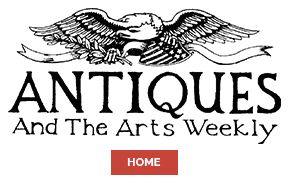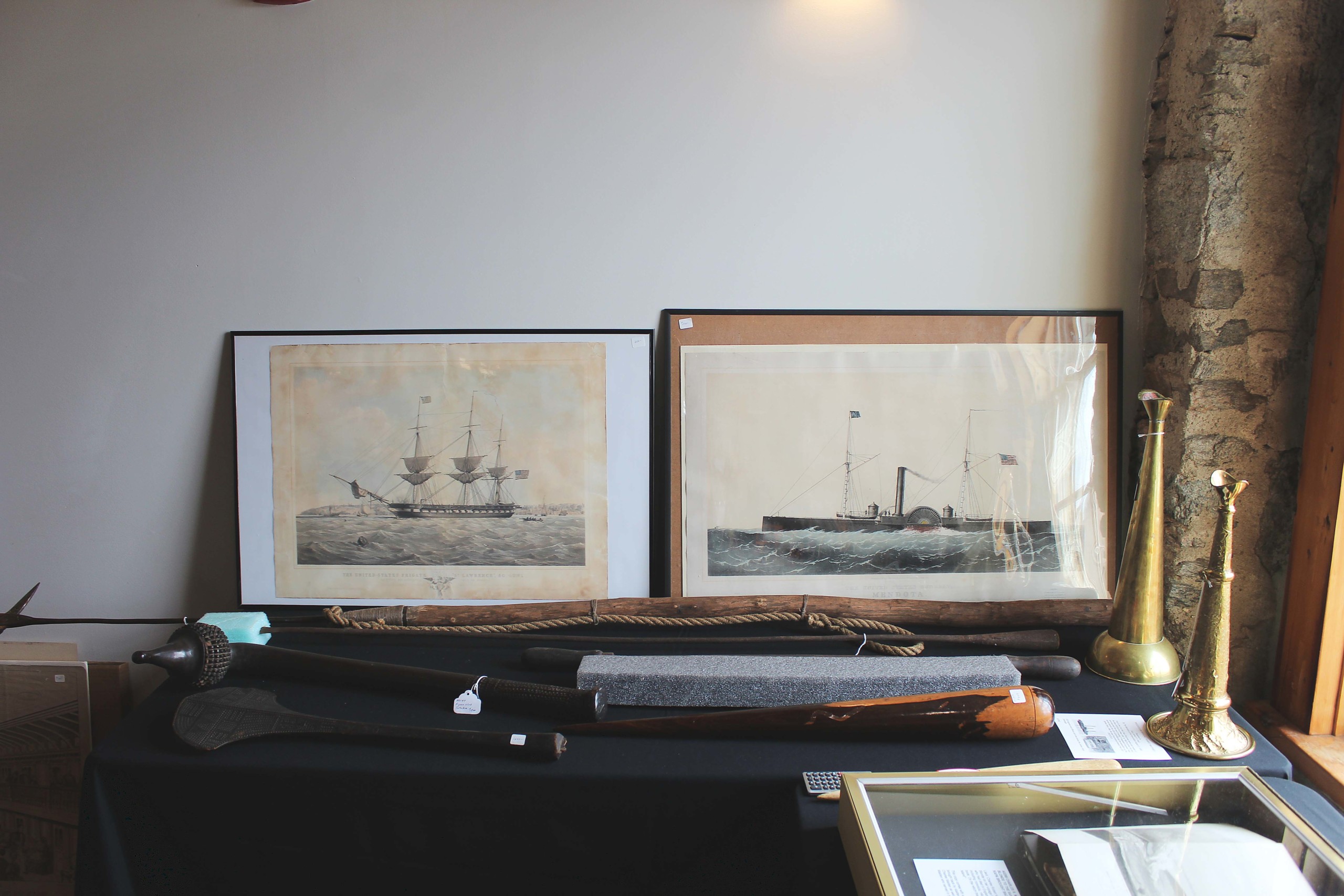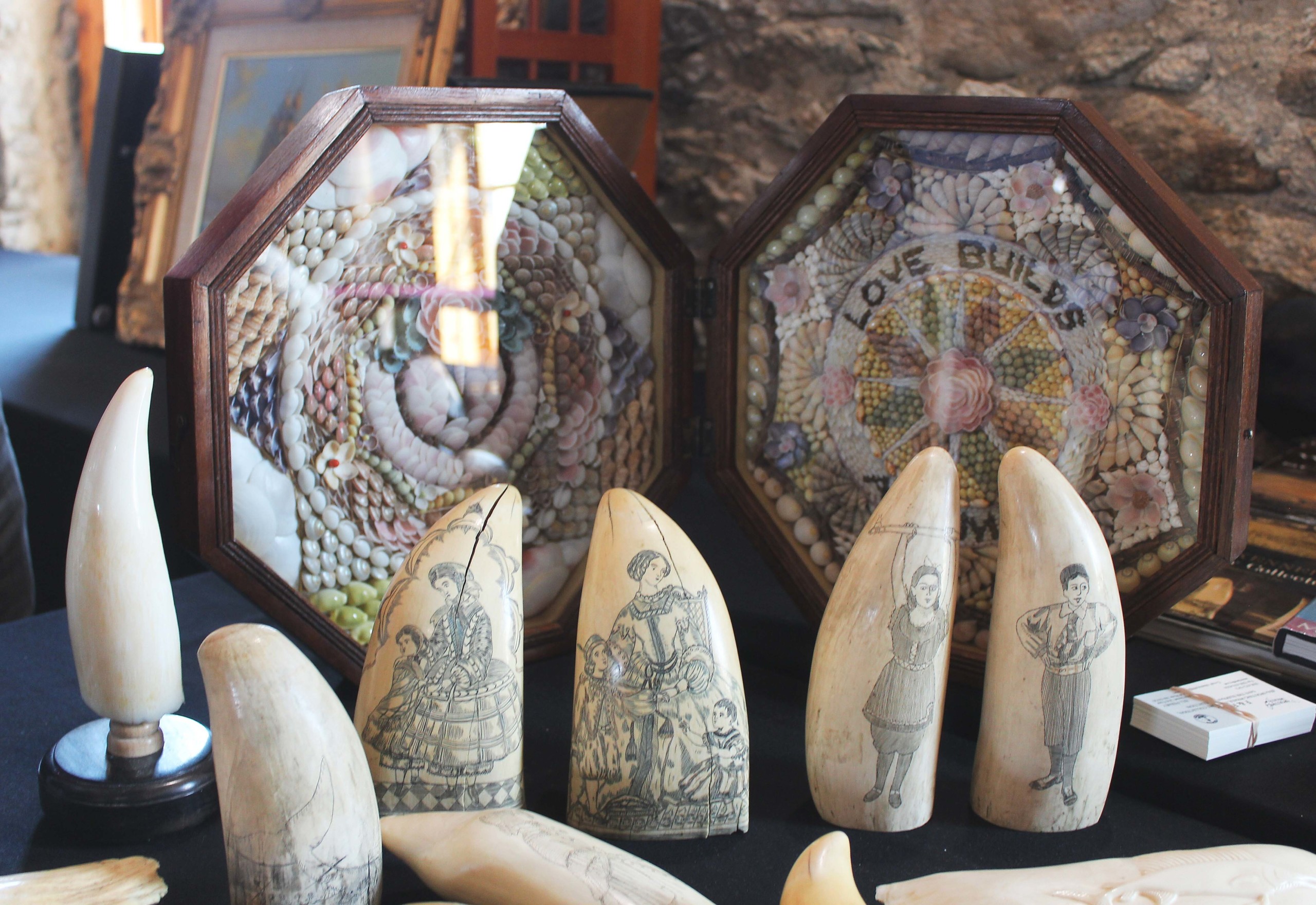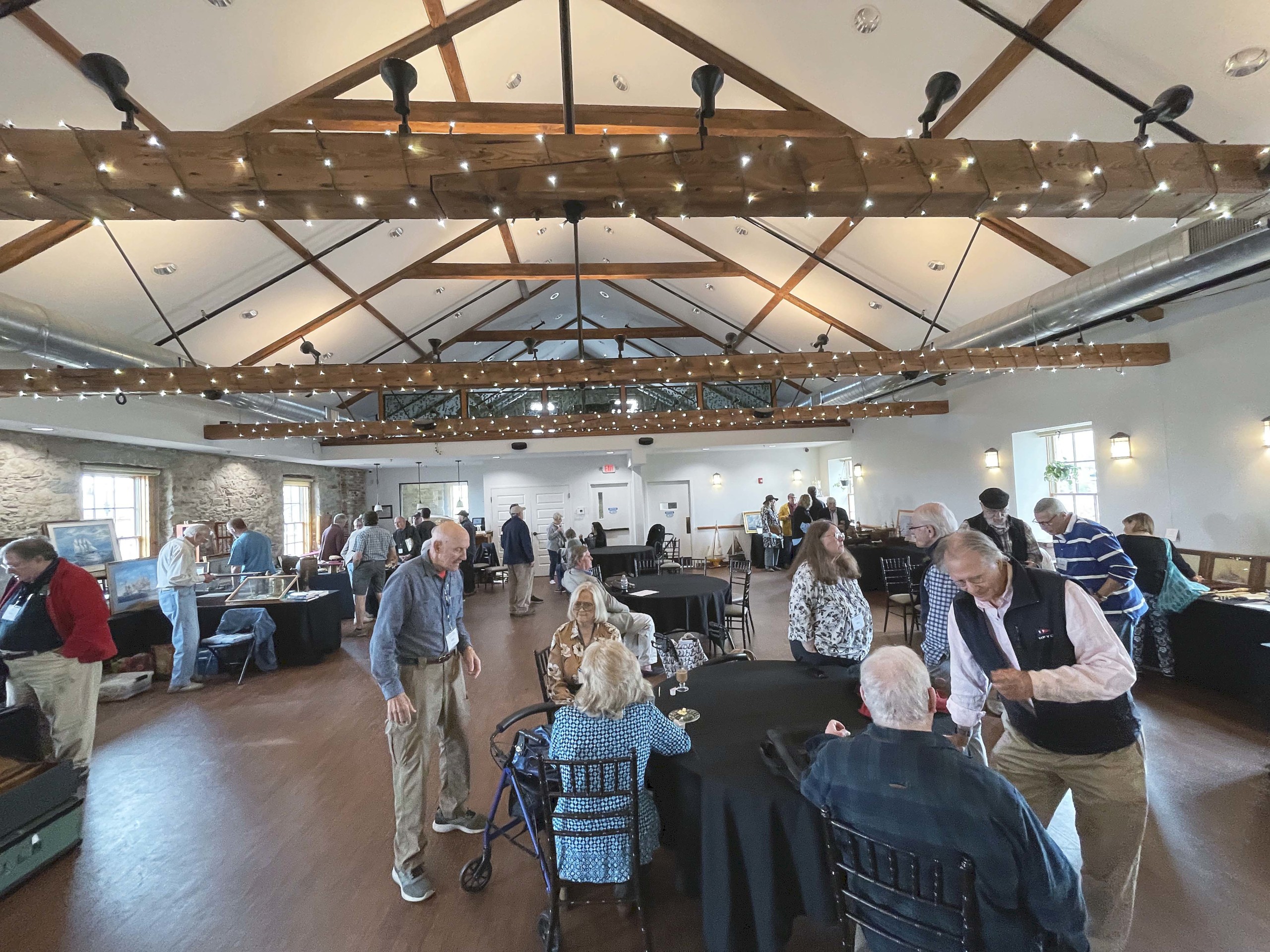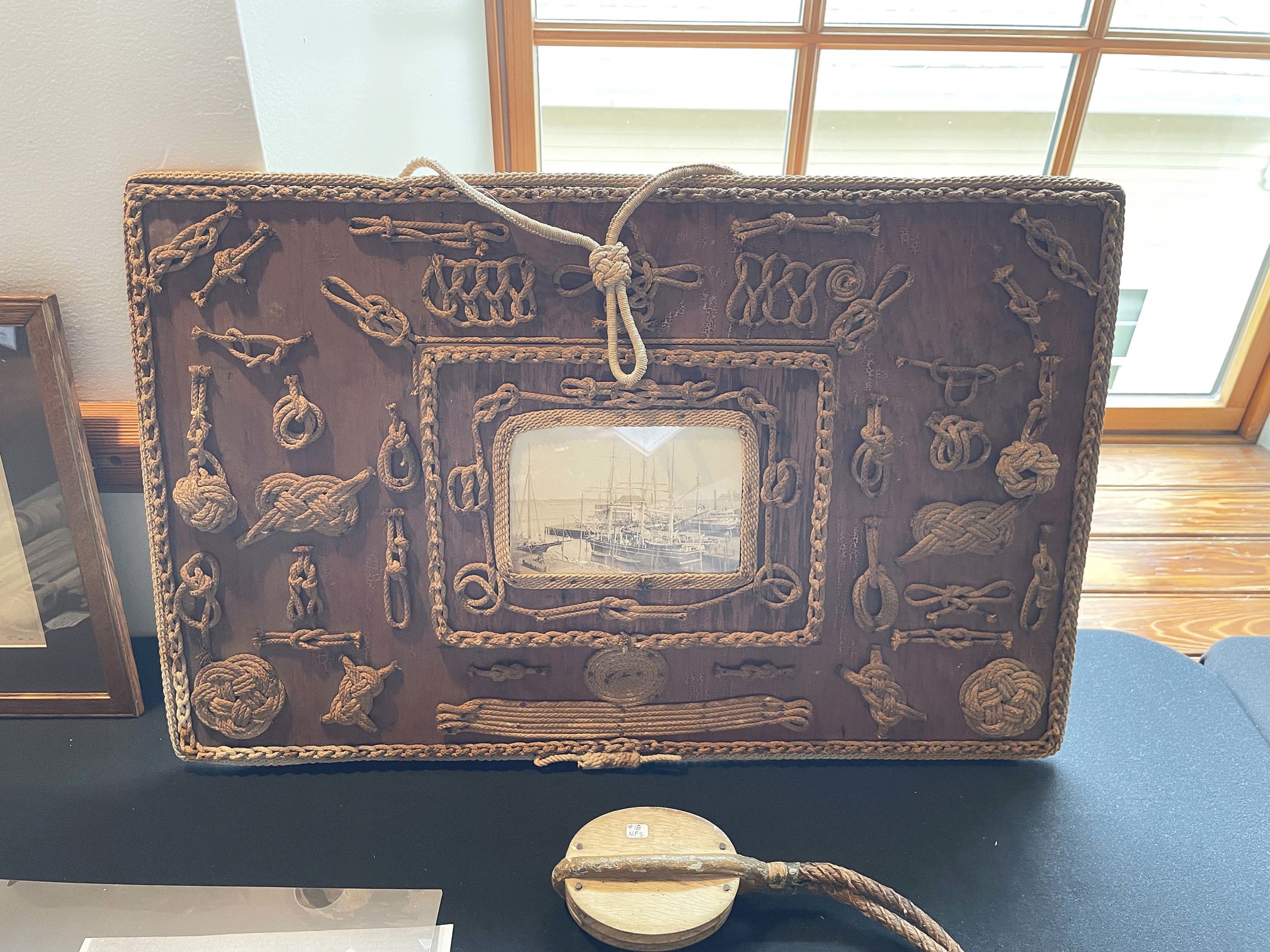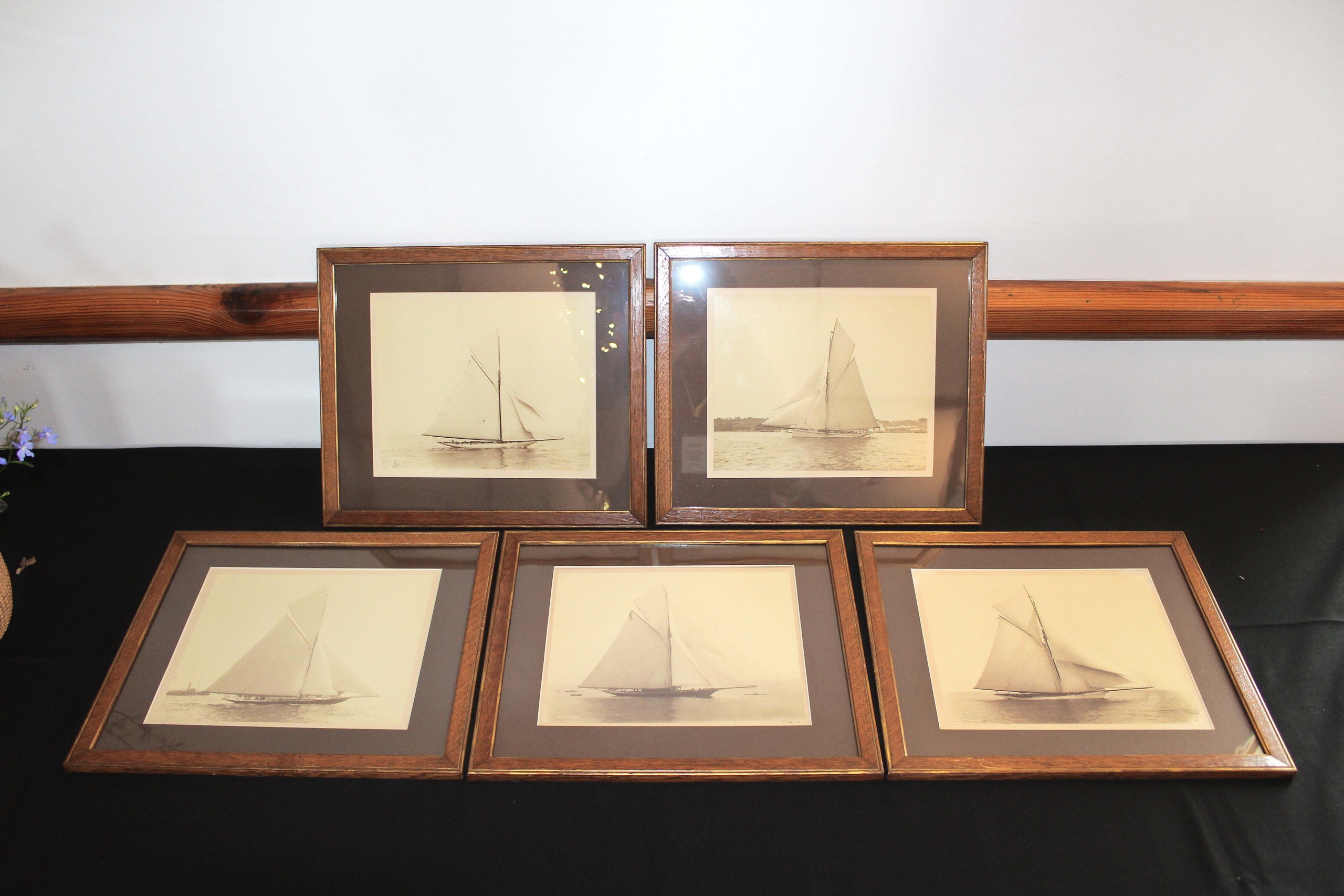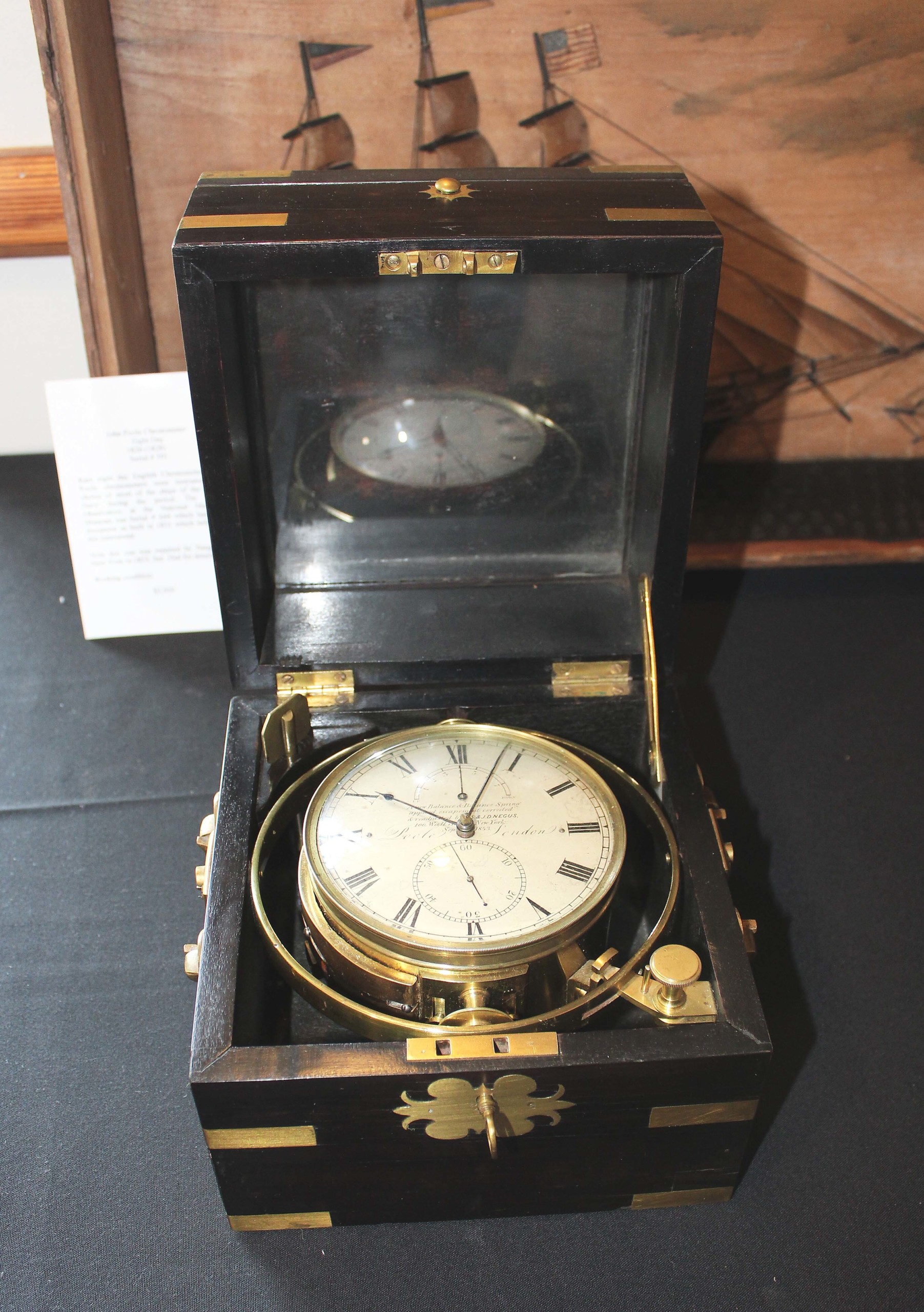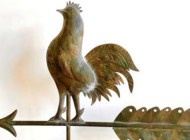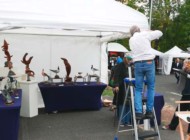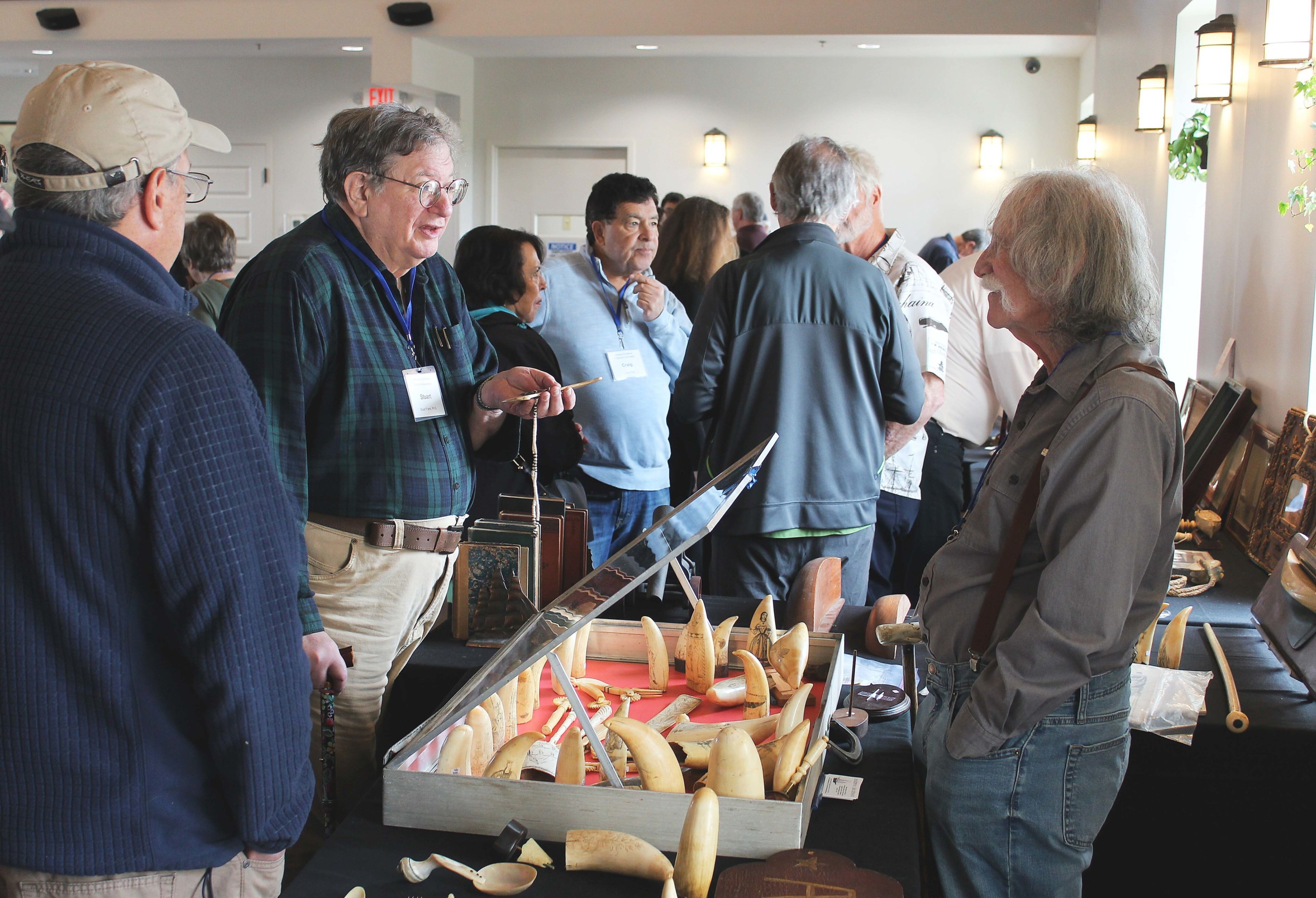
If anyone knew about the status piece Andrew Jacobson (right) had, we guess it would have been Stuart Frank, PhD (left, holding the collar). Andrew Jacobson Marine Antiques, Ipswich, Mass.
Review & Onsite Photos by Carly Timpson
NEW BEDFORD, MASS. — The 34th annual Scrimshaw and Nautical Antiques Weekend and Show brought mariners from all across the county to the New England whaling town of New Bedford. The small show, which featured seven dealers, was large in spirit and depth of merchandise. Additionally, attendance was bolstered by the schedule of events hosted by the Antique Scrimshaw Collectors Association. The Show, on May 9, kicked off the weekend. However, Symposium Sessions, Banquet and an Evening Program on Saturday, May 10 and a “Field Trip” to Martha’s Vineyard to visit the Martha’s Vineyard Museum and the Carnegie Heritage Center in Edgartown, have lunch at Bad Martha Farmer’s Brewery and to view a world-class private scrimshaw collection at the home of Jonathan and Jennifer Blum on May 11 helped draw a substantial crowd of interested shoppers.
Show chair Mary Boger said, “It’s a smaller show this year due to a constellation of reasons, but we do have a new dealer and some really wonderful stuff. Attendance was very good, there was a big rush to get in with lots of people in line waiting.”
The new dealer, Guy Gerhard, came down from Phippsburg, Maine, to sell items from his personal collection. He told us, “I’m mostly a collector, but I do a couple shows a year to support my 30-year hobby.” Early in the show he sold a ship in a bottle and an antique three-mast freight or Packard ship model on a custom base, which was later being offered by another dealer across the way. He also had lots of artwork, including ship portraits and maritime scenes, a USS McFarland destroyer model, a powder horn carved by Ben J. Ames, a Rushmore searchlight and a compass and binnacle with an affixed oil lamp.
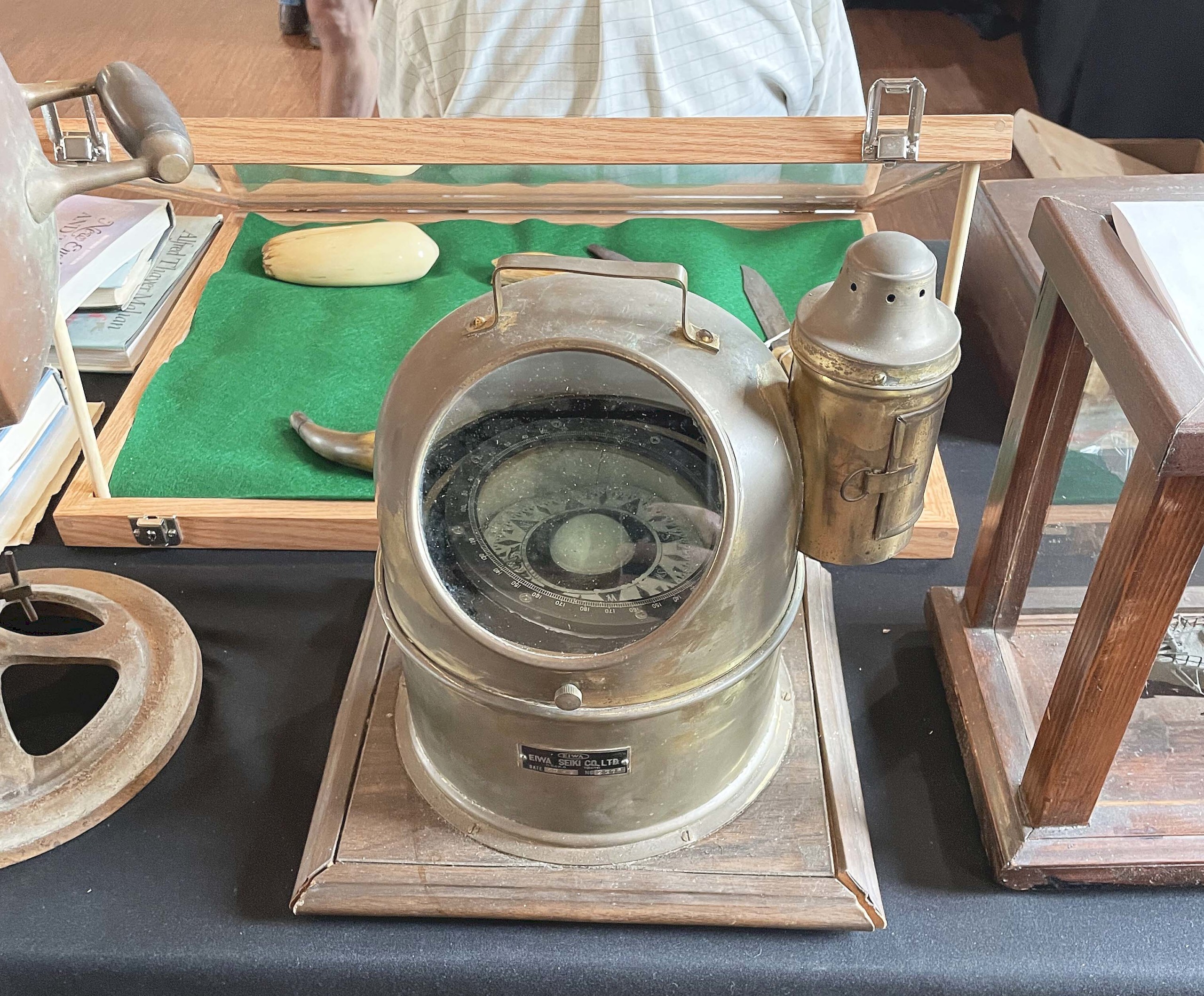
Lost your way? Guy Gerhard has you covered with this compass and binnacle. Phippsburg, Maine.
Another dealer who had framed art was David White who runs White’s Nautical Antiques, North Yarmouth, Mass. In White’s booth was a “rare compilation painting of four boats, depicting four eras of shipping” done by Antonio Jacobsen (1850-1921). The primary focus in the painting was the Naiad, a British tall ship from the late 1700s. The other three boats — an early 1800s schooner, a late 1800s steamer and an early 1900s military boat — were unnamed. White also had a “very, very excellent chronometer, a really good boat model” and had sold a nice swift and carved bone garden figure. Even just a half hour into the show he was already reporting having a great day.
Catching up with us after the weekend closed, Fall River, Mass., dealer Bill Feeney shared: “The show was excellent with a lot of interest in the antique scrimshaw. This was my sixth year as a dealer in attendance at the show. The pieces that drew most interest at my booth were antique scrimshaw pieces and books on scrimshaw; some whaling tools also drew interest. We were pleased with the interest and sales at the show. I met with some regular customers as well as made some new introductions to new customers. I like to see a lot of old friends, and it is the only show I do that is solely antique scrimshaw. The customers are very knowledgeable about the products.” One of the most unique items that Feeney brought with him was a three-pound whale’s tooth, which he said was very exciting since most that large are housed in museums. Another was a scrimshaw tooth done in 1831 by Captain George Clapham (1812-1847), which he was selling with a full writeup about the object and its artist.
A friend of Feeney’s, William “Bill” Rill, was set up on the other side of his booth. Rill, who is from Michigan, collects contemporary scrimshaw and was exhibiting his personal collection. While none of his items were for sale, Rill did find some pieces for himself at the show.
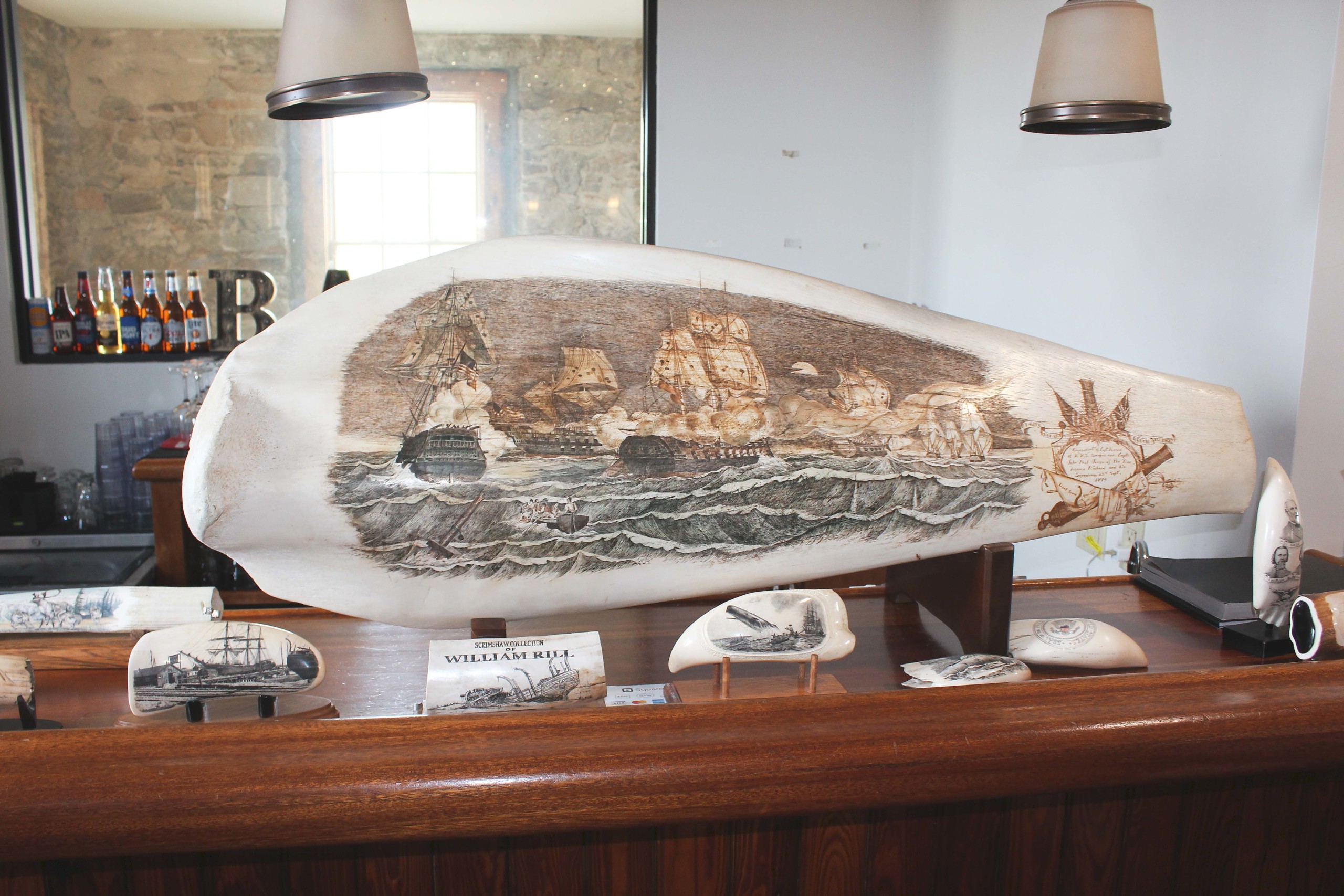
William Rill’s contemporary scrimshaw collection was on display. Though he was not selling anything, he did acquire a few nautical items for his personal collection. Michigan.
Making the trip East to the show for a second year was Rod Cardoza of the San Diego, Calif.-based West Sea Company. He told us, “The show was good, we sold a lot of things, but our prices were below market. We traveled across the country from California to do the show, so we had to be certain our sales would pay for the trip. Our highest-dollar sale was an amazing scrimshaw swift made entirely of whale tooth ivory — very rare! We deal in all forms of nautical antiques: ship paintings, ship models, scrimshaw, nautical instruments, clocks, antique diving, scientific instruments, etc. But this show, by its nature, was focused on scrimshaw.”
One dealer who has been attending the show since its inception is Andrew Jacobson. The Ipswich, Mass., dealer was situated at the show’s entrance and was almost constantly busy making sales or chatting to interested shoppers. Visitors were especially drawn to an unusual carved collar or throat or chest ornament that Jacobson believed was likely some sort of status symbol from the early Nineteenth Century, possibly linked to the Royal Navy. “There are very few examples like this known, we’re all trying to figure out its history,” he explained. Besides this piece, he also had lots of scrimshaw teeth, pie crimpers, toothpicks, flatware, busks, a ship sign and a collection of nautical books.
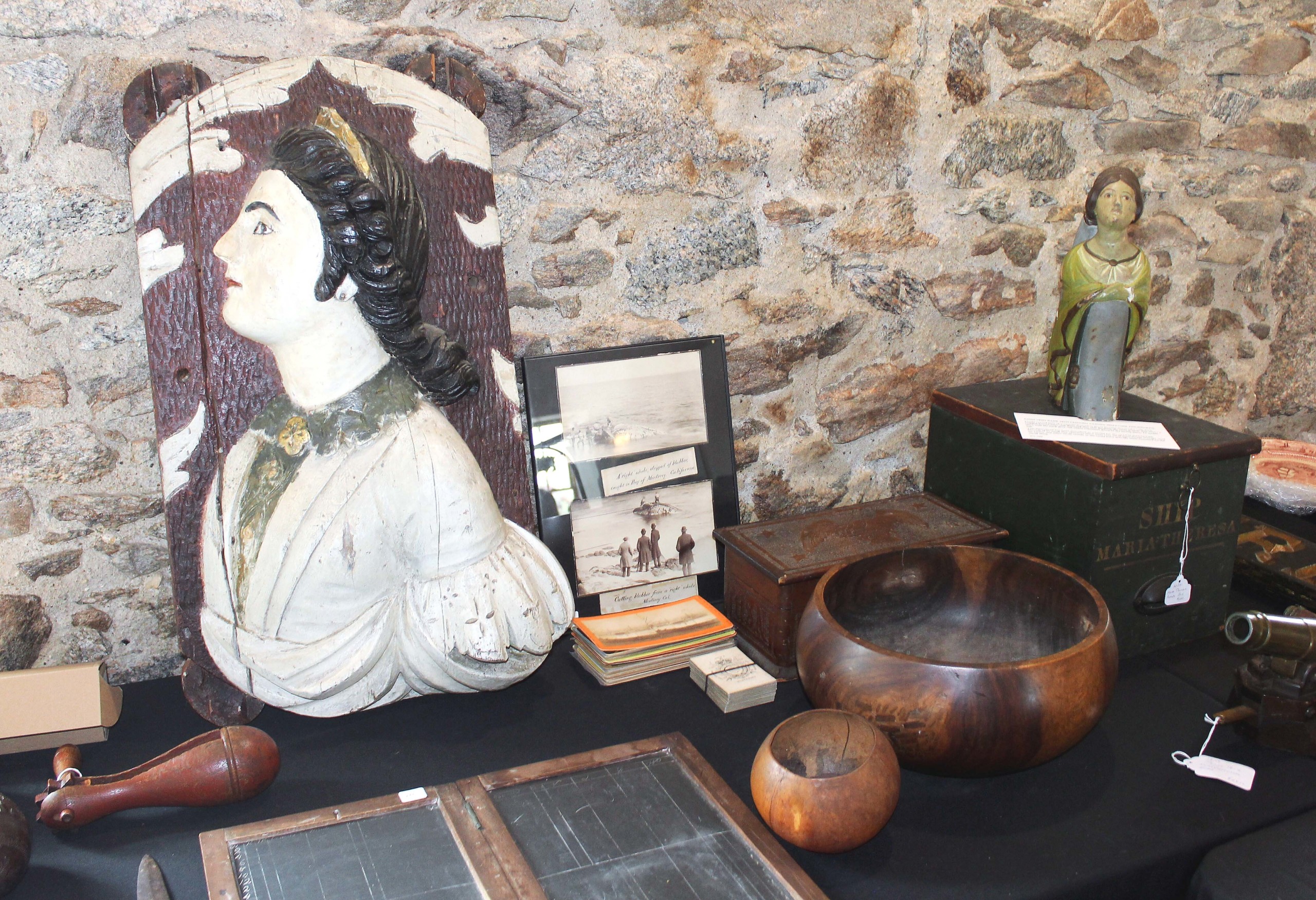
Ryan Cooper indicated that the stern carving of a woman (left) and small Nineteenth Century figurehead model (right) were among his most intriguing pieces. Ryan M. Cooper Nautical Antiques & Art, Yarmouth Port, Mass.
Another longtime dealer is Ryan Cooper, who reported, “The show was very good for me as well as everybody, so I believe. There was overall interest in many things, though the figurehead and stern carving attracted the most attention.” That figurehead was rare miniature (13 inches high) model carved in the Nineteenth Century. In his writeup for the piece, Cooper explained, “This figurehead has been described as a model for the sloop Bayadere because of its small size. However, there were very small figureheads actually used on yachts and other small vessels, so she could have actually been mounted on the small sloop.” The stern carving was from the mid Nineteenth Century and was inscribed on the reverse as being from the Norwegian ship Freya. Other unusual items in the Yarmouth Port, Mass., dealer’s booth included a selection of Polynesian and Oceanic items, including a Hawaiian koa wood calabash bowl with indigenous repairs and a Fijian totokia club. After the show, Cooper noted, “The nautical show is unique with no other show that specializes in nautical antiques. Interestingly, there were half the dealers that usually do the show, because of prior commitments. But that didn’t hurt the show’s overall success.”
For information, www.antiquescrimshawcollectors.org.
